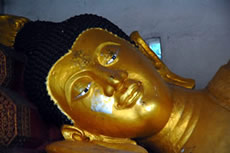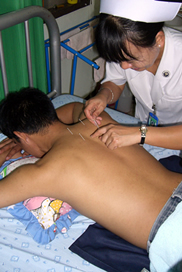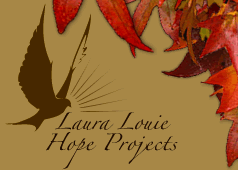
Welcome to the Laura Louie Hope Projects Web site!
If you read only one page, let it be this one, as it outlines the focus, vision and mission of our organization.
 |
| Dr. Laura Louie, ND, MSc |
|
We are a small but dynamic Canadian non-profit organization created to provide cost-effective healthcare and educational programs for adults and children in developing countries. The focus of our work is to improve the quality of life for underprivileged persons through community-based grassroots projects. Since 2004, we have worked with people living with and affected by HIV/AIDS (PLHIV).
The Laura Louie Hope Projects (LLHP) programs concentrate on improving the quality of life (QoL) of underprivileged people through:
- Cost-effective medical care, including acupuncture and nutritional counseling;
- The creation of self-sustaining garden projects;
- Income generation and sustainable energy projects; and
- The provision of a variety of HIV/AIDS educational workshops in disease prevention, stigma/discrimination and gender equality.
The majority of our projects are staffed by a team of volunteers who dedicate their time and energy toward these important goals. |
Therapeutic Interventions
Discussions concerning HIV/AIDS generally point to antiretroviral therapy (ART) as the optimal intervention that has been proven to extend the lives of PLHIV. This drug therapy is expensive and is more accessible in developed countries and places such as Thailand rather than in India or Africa. ART may also be accompanied by extreme side effects that include pain, peripheral neuropathy, diarrhea and insomnia.
Fortunately, these side effects and the symptoms of chronic HIV infection can be improved by acupuncture. Traditional Chinese Medicine (TCM) has a long history of enhancing the body’s immune function. For HIV and AIDS patients, TCM allows for symptom treatment without the need to add extra medications to an often complex drug regiment. By decreasing HIV and ART-related symptoms, acupuncture has the potential to significantly improve the quality of life for these patients.
Thailand
 In 2004, the Laura Louie Hope Projects established the Mae On Project, a pilot project using acupuncture for symptom relief and improved quality of life for PLHIV in rural northern Thailand. At the end of 2005, amongst this country’s population of 64.2 million, 580,000 adults and children were estimated to be living with HIV/AIDS and approximately 21,000 AIDS-related deaths were recorded ( 1 ).
Therapeutic strategies to help patients in resource-poor settings are greatly needed and was one of the key reasons for the establishment of this project. In 2004, the Laura Louie Hope Projects established the Mae On Project, a pilot project using acupuncture for symptom relief and improved quality of life for PLHIV in rural northern Thailand. At the end of 2005, amongst this country’s population of 64.2 million, 580,000 adults and children were estimated to be living with HIV/AIDS and approximately 21,000 AIDS-related deaths were recorded ( 1 ).
Therapeutic strategies to help patients in resource-poor settings are greatly needed and was one of the key reasons for the establishment of this project.
The Mae On Project was launched in April 2004
with three main objectives:
- To develop a pilot program to train local medical staff in acupuncture as an adjunctive treatment for PLHIV at Mae On Hospital;
- To create a free clinic at Mae On Hospital to provide acupuncture for PLHIV; and
- To undertake an evaluative pilot study using quantitative and qualitative data that would assess the efficacy of acupuncture on QoL, the symptoms of chronic HIV infection and the side effects of ART therapies.
 |
| Thai Nurse, Ms. Unchalee Pultajuk, Doing Acupuncture at Mae On Hospital |
The Mae On Project has demonstrated the feasibility of establishing a hospital-based acupuncture clinic in less than 12 months. Using local nursing staff, the clinic has provided more than 900 treatments to people living with HIV/AIDS. Acupuncture is acceptable to this population and many participants requested that similar clinics be started in other districts to accommodate those unable to travel to the Mae On Hospital. The hospital director and head nurse have seen such positive outcomes since the program’s inception that they have requested training for more nurses.
Our assessment tools and personal experiences show that acupuncture has many important benefits for this resource-poor area.
- Acupuncture treatments were well-tolerated and safe, with no adverse reactions reported. When used correctly, this treatment modality has few side effects and no biochemical interactions with allopathic medications such as ART.
- The treatments are inexpensive and cost-effective. The average cost of a weekly acupuncture treatment for one participant is approximately $1.55 CA. This translates to $6 CA per month per patient, a very small price for such significant results!
- There are also several secondary gains from acupuncture. Many participants experienced improved appetite, better sleep, less stress, and more energy, even though they were not treated directly for these conditions. Traditional Chinese medicine and acupuncture balance the whole body and often lead to dramatic upturns in patients’ physical, mental and spiritual lives.
 |
| Thai Nurse, Ms. Duangdean Ruensa, Doing Acupuncture at Mae On Hospital |
|
For more information about Mae On Project please click on the Research link. Details of a recent evaluation of the Mae On project were presented at the 17th International AIDS Conference in August 2008 (Click on Presentation and Publication).
“Although our project makes a small impact on worldwide AIDS numbers, it has made a very tangible difference in small communities of HIV patients and their families,” according to Dr. Louie. |
Based on four years of successful operations in Thailand, Projects principals began to consider starting a similar project in another resource-poor part of the world.
India
In 2007, Dr. Louie met with Father Abraham, a Jesuit priest from Canada who has worked with the poor in northern India for over 50 years. He introduced her to several organizations in the Darjeeling/Darjeeling region that provide services to people living with HIV/AIDS and they expressed interest in the Projects’s programs.
The majority of the people in this remote region are refugees or migrant workers from Tibet, Nepal, Bhutan and the impoverished province of Bihar. Dr. Louie is undaunted by the considerable challenges posed by Darjeeling, which she calls “a forgotten part of India.”
“There has only been an HIV program there since 2002, which is shocking,” she says, “and the stigma and gender inequality are enormous. Women aren’t getting tested knowing that they and their families will be discriminated against if they’re (HIV) positive.”
The Projects is poised to continue its non-profit initiatives by establishing locally run, sustainable programs in Darjeeling. Principals are planning to launch an extensive, proactive, medical and educational program similar to the Mae On Project in Thailand; however, the Darjeeling project will have a more regional focus on essential sustainability.
The Darjeeling Project initiatives include:
- Using acupuncture techniques to address substance abuse, improve the symptoms of chronic HIV infection, and reduce the side effects of ART as well as to provide complementary health care to the poor;
- Offering nutritional counseling to patients;
- Providing a culturally sensitive educational component including workshops and counseling to help people better understand HIV and its stigma, along with gender equality issues.
The Darjeeling project will also include the creation of energy efficient stoves and improved housing as well as educational scholarships for underprivileged children.
Looking Ahead
“You begin saving the world by saving one person at a time;
all else is grandiose romanticism or politics.” |
~ Charles Bukowski |
Based on the promising outcomes of the Projects’s work in Thailand and now India, “our goal is to initiate and be a part of each new project on the ground level,” Dr. Louie says, noting that all programs “must be sustainable – that means we train local staff to run all our programs and basically work our way out of a job.”
The plan is an ambitious one. But the goals are achievable and hundreds of patients have already experienced dramatic improvements in mind, body and spirit. Thanks to your generosity, the Laura Louie Hope Projects will continue its life-altering work in other resource-poor parts of our planet, “saving the world, one person at a time.”
On a more sombre note, Tides Canada Foundation recently informed us that they are shutting down the Challenge Fund, which the Laura Louie Hope Projects Fund is a part of.
New regulatory interpretations make it untenable for Tides Canada to operate the Challenge Fund.
What does this mean? Because of this change the Laura Louie Hope Projects will no longer be under the umbrella of Tides Canada Foundation and therefore will not be able to provide tax charity receipts.
In addition, the Laura Louie Hope projects will have no charitable status. Despite these hurdles, the work will continue on with the Mae On and Darjeeling projects.
For more information about the Founder and Directors of the Laura Louie Hope Projects, please click here.
Sources
Statistics on the world epidemic of HIV & AIDS were published by UNAIDS/WHO in May 2006 – UNAIDS/WHO 2006 Report on the global AIDS epidemic – cited on www.avert.org.
|



